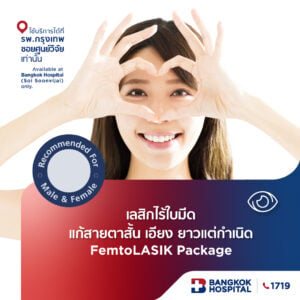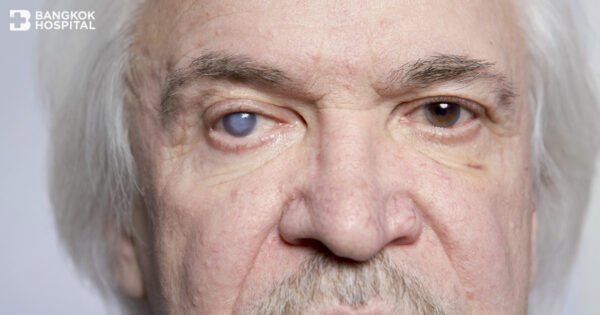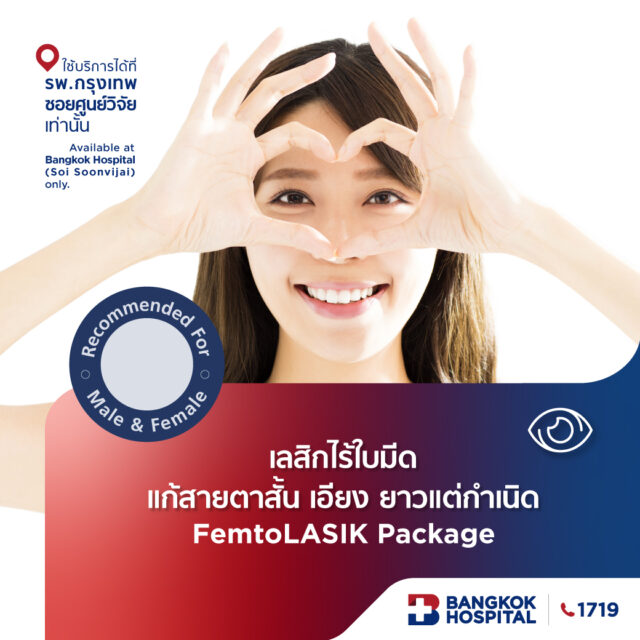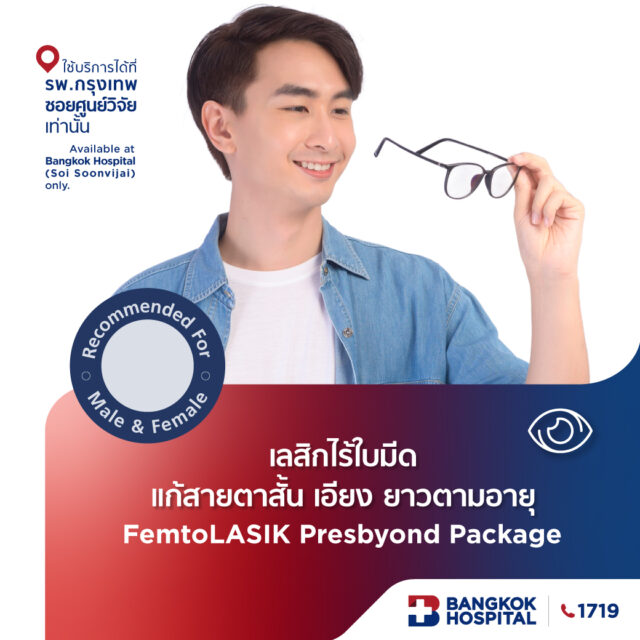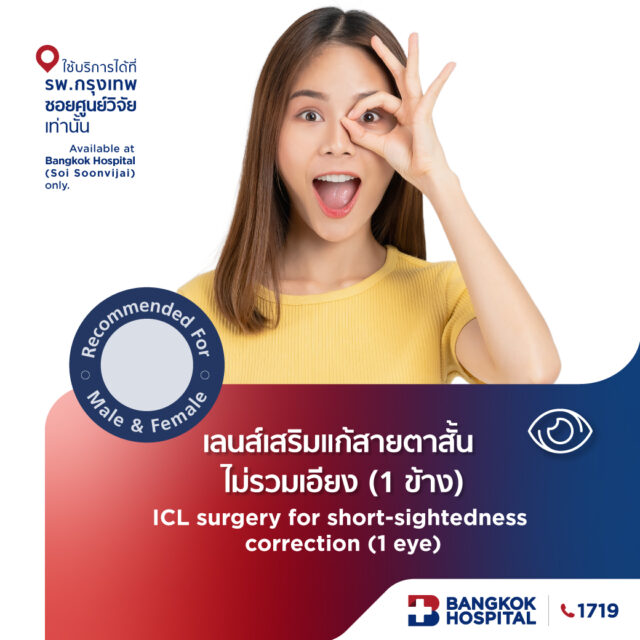As Thailand is entering aging society, there is an increasing concern for the elderly about blindness and low vision. The number 1 cause of these problems locally and internationally is cataract. It is found that 47.8% of blindness around the world is caused by cataract. World Health Organization estimates that globally there are 18 million people who have cataracts and suffer from blindness in both eyes. Moreover, many patients consult their ophthalmologists after their cataracts are already fully mature. There are also patients who believe that they have to wait until their cataracts are mature before they can have a surgery. However, this is actually dangerous and difficult to treat. Therefore, it is best to visit an ophthalmologist early.
What is Cataract
Cataract forms when the lens inside the eye changes its protein structure and develops a cloudy patch. Normally, the eye’s lens is clear and serves as a focal point of light onto the retina. If the lens is cloudy, it will affect the reflection of light. As a result, the retina gets less light which causes blurry vision.
Cause of Cataract
Cataract is often found with aging. This natural degeneration of lens starts after the age of 40. It is found that 20% of people over 40 years old have cloudy lens, and more than half of them will develop cataracts when they are 60 or older; but the condition may not cause vision problems until years later.
Although cataract is mostly found in elderly, it can occur at every age due to, for examples:
- An accident or any trauma around the eyes area
- Hereditary or unknown cause which is often found at birth
- Complication from other diseases such as diabetes, malnutrition, obesity, etc.
- Consistent use of certain medicine such as steroid, etc.
- Radiation treatment such as for cancer which may need radiation around the head area, etc.
- Past history of eye treatment such as eye infection or vitrectomy or ocular surgery
- Exposure to UV or sun ray for a long period of time
- Smoking and drinking
Stages and Symptoms of Cataracts
It is a fact that cataract is unpredictable, as to how quickly or slowly it will develop. In general, though, cataract is an age-related affliction which develops gradually. But cataract from other causes may progress faster and have more impact on the eyesight. There are different treatments for the stages of cataracts depending of the severity of symptoms and impact on the patients’ daily routines.
Early Stage
Most cataracts in an early stage develop slowly, and gradually affect the eyesight. Patients may not even realize it. The symptoms may include:
- Blurry vision
- Double vision in a single eye
- Seeing “halos” or shadows around lights
- Being sensitive to light
- Seeing fading or yellowing of colors
- Increasing difficulty distinguishing colors or levels of brightness
- Frequent changes in eyeglasses or contact lens prescriptions. Some hyperopia patients may become more nearsighted because of cataract and can now read at close distances without reading glasses.
Late or Advanced Stage
As cataract progresses, the symptoms will be more severe. These are:
- More blurry or cloudy vision, especially during daytime or under a bright light
- Difficulty seeing in the dark
- Increasing difficulty reading
- Seeing a white spot in the middle of the pupil
- Loss of vision
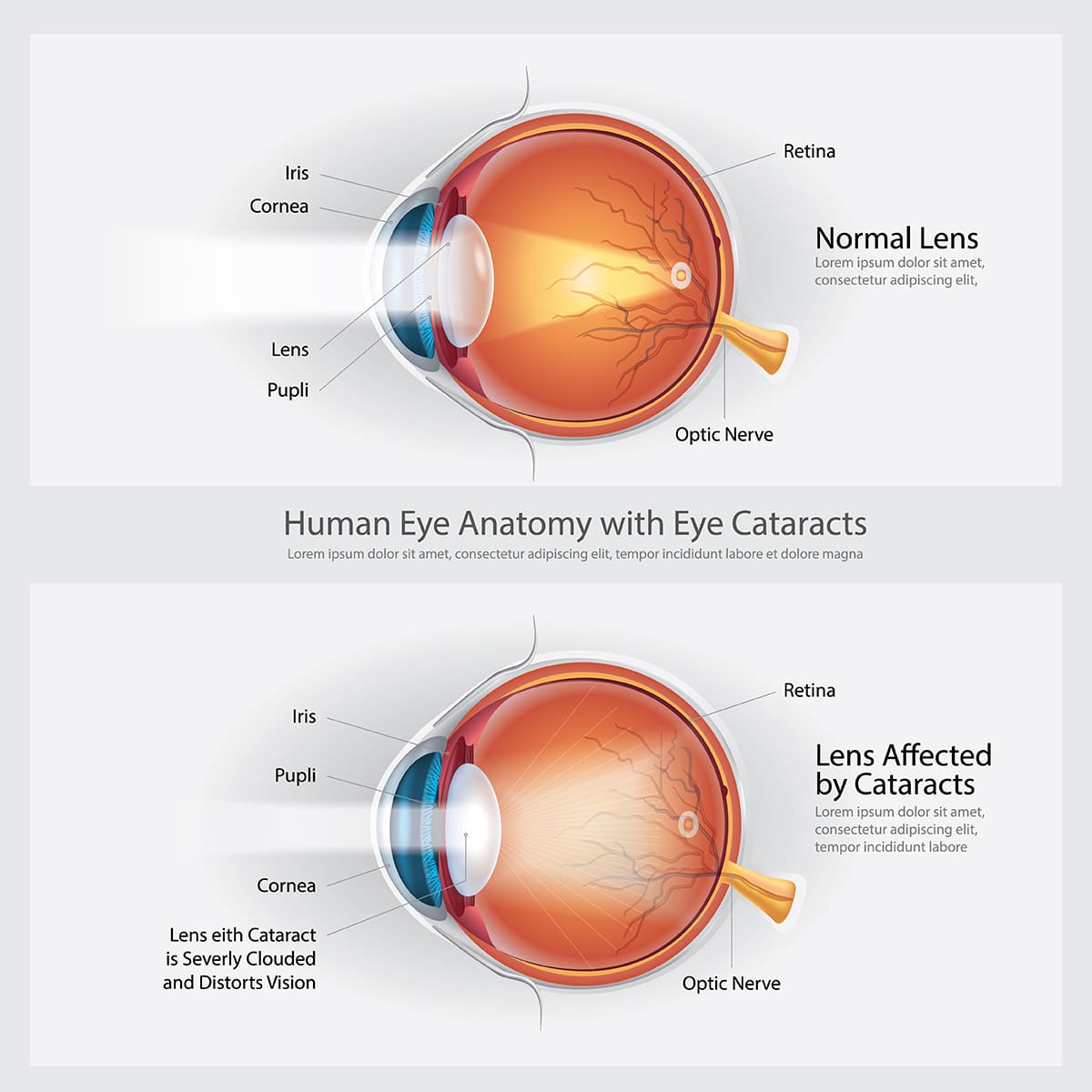
Cataract Diagnosis
When you suspect that you may have cataracts, please consult an ophthalmologist for a proper diagnosis. The general eyes examination includes visual acuity test, eye pressure test, pupil dilation to check the retina in detail and to identify the extent of the cataract. All of these tests are to determine whether the problem with your vision is due to cataract only or is affected by other diseases as well. Some patients may need additional tests such as Optical Coherence Tomography (OCT), visual field examination, etc.
Treatment for Cataracts
For an early stage, cataracts can be mitigated with eyeglasses or adjusting ambient light that may improve the ability to see. However, the cataracts will gradually develop until they interfere with the patient’s vision as well as their daily routine, requiring new and higher-powered lenses more frequently. Today, there is no medicine or eyedrop to treat or cure cataracts. The only treatment available is through surgery, which is easier at an early stage than when the cataract has matured. Such a surgery offers less possibility of complications, and quicker recovery time. If the patient does not have any other affliction around the eye or part of the brain that controls the vision, or the patient does not experience any complication from the procedure, the patient’s vision will improve not long after the surgery and can resume their daily routine with markedly improved quality.
Indicators When Cataract Surgery Is Needed.
- The cataract is so advanced that it causes problems with your vision and interferes with your daily life.
- The cataract is so advanced that it may lead to other problems such as glaucoma.
- The cataract is obscuring or preventing proper examination or treatment of the retina – for example, in the case of a diabetes patient where this is necessary for diabetic retinopathy diagnosis.
Can Cataracts Be Left Without Surgery?
If left untreated, the cataract will continue to develop until it becomes mature. The eye’s lens that once was clear now becomes completely cloudy which can lead to other severe conditions:
- Deteriorating Vision – This will interfere with your daily life, causing you to lose self-confidence by preventing you from enjoying normal activities. It also increases the risk of accidents such as while driving, stumbling or falling – all of which can be fatal.
- Harden Lens – Your eye’s lens can become harden, making surgery more difficult which may result it a bigger wound and increase chances of complications after the procedure: such as torn posterior lens capsule, sagging or torn posterior lens capsular suspensory ligament, dislocated lens fallen into the back of the eyeball which will require additional complex corrective surgery to the eye involving the vitreous and retina – increasing surgical as well as recovery periods, and the outcome may not be as good as expected.
- The lens can become so swollen that it blocks the tears duct – This situation can cause acute glaucoma or lens protein leakage, leading to severe inflammation and pain in the eye, and possible blindness.

Cataract Surgery
There are 2 main techniques for cataract surgery. These are:
1) Phacoemulsification – This technique uses ultrasound or high-frequency soundwave to disintegrate the cataract, and the fragments are thenremoved through suction. Small surgical tools are placed inside the eye via a microscopic incision – only about 3 millimeters wide – so that no suture is required. The surgery takes about 20 – 30 minutes and the patient can return home afterwards. Usually, the patient’s vision improves rapidly after a short recovery period, and the patient can resume normal activities quicker.
As an advantage of this technique, it is possible to select foldable lens that can also correct myopia, hyperopia, and astigmatism; or to use artificial lens that provides progressive focus, so as to lessen dependency on eyeglasses – especially reading glasses. Thus, phacoemulsification offers cataract treatment at the same time as an opportunity to correct other common vision conditions.
However, this surgical technique can be used for early stages of cataract only. If the cataract is completely mature or has become too harden, it cannot be treated by this procedure.
2) Extracapsular Cataract Extraction (ECCE) – This technique requires a wider incision – about 10 millimeters – in order to remove the entire lens and replace it with a rigid artificial one. This is a more traditional method and is used to remove a mature cataract. The wider incision requires sutures, so the surgical and recovery times are longer.
However, before any cataract surgery, the surgeon will examine all parts of the eye in detail, including measuring and calculating the power of the replacement artificial lens that will be inserted during the procedure. The surgeon will provide every piece of information to the patient and enquire about the patient’s daily routine as well as the patient’s desire and expected outcome. Then, together they will determine the method for treatment and the most suitable type of lens, to ensure the best possible surgical result fitting the patient’s eye condition.
Is There Any Risk from Cataract Surgery?
For every surgery, there is always a risk. However, today a cataract procedure by an experienced ophthalmic surgeon utilizing a set of modern tools is considered a surgery that has high success rate – with reduced complications, and the possibility of undesirable outcome is very miniscule. The procedure is quick and almost painless, typically requiring only local anesthetic.
Complications that may arise during or after the surgery includes dry eyes, corneal edema, ocular hypertension, bleeding inside the eye, vitreous degeneration, macular edema, peeled retina, inflammation or infection, residue lens fragments, torn posterior lens capsule which prevents the insertion of the artificial lens or the new lens cannot be inserted properly – this will require additional correction with eyeglasses or, for some, another surgery to replace the artificial lens.
If you notice any of the symptoms and suspect you might have a cataract, you should consult a specialist and have your eyes examined as soon as possible. Do not ignore it until the cataract has become mature. The longer you wait, the more difficult it is to treat. Your daily life can be adversely affected.


